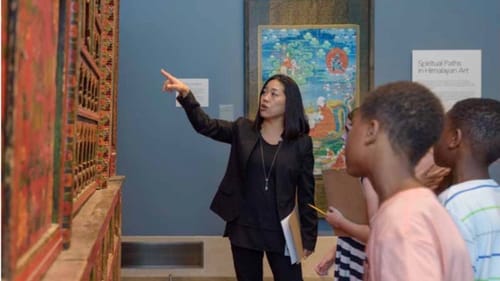Stay in the Loop
BSR publishes on a weekly schedule, with an email newsletter every Wednesday and Thursday morning. There’s no paywall, and subscribing is always free.
Creative intervention
Can arts education save American democracy?

It’s a Tuesday afternoon in January, and my six-year-old daughter has covered a baking sheet in a thick mound of shaving cream speckled with blue and yellow puddles of food coloring. We are following instructions via Skype from a dear family friend, an artist in Texas, who has been generously guiding us through weekly art lessons. Today we’re learning how to make marbled paper by tapping a blank page on top of the stained shaving cream, but my daughter has missed the point and is reveling in the tactile bliss of squishing the colorful shaving cream through her fingers, blurring the individual lines of color we were supposed to be creating. But that’s okay because what she’s learning from art-making stretches way beyond the tangible outcome.
Our Tuesday afternoon “art class with Yaya” arrived as a necessary intervention. The stress of remote learning and pandemic isolation had become almost unbearable. My daughter’s long online school days turned her against reading and were marked by crying fits and destructive tantrums. The only things that cheered her up were music, drawing, and painting. Now the tedious chaos of our school week is anchored with a joyous purpose that may also expand empathy and critical thinking skills.
Everyday specials
This is not to say that my daughter’s first-grade schoolteacher is doing a bad job. She’s doing an amazing, impossible job with limited resources. I have nothing but love and gratitude for her and all teachers, especially now. And we are very fortunate to still have “specials” like art and music offered once a week through our Delaware public elementary school, though the “specials” teachers all work at multiple schools simultaneously.
But I believe those arts education classes should be more than “specials.” I want them to be the “core academic curriculum” described in both the Elementary and Secondary Education Act, and the No Child Left Behind legislation—the latter of which has essentially left every child behind by blurring the lines between disciplines, smooshing everything else to fit under the heavily tested areas of Math and English Language Arts.
The education system in our country was deeply flawed before Common Core and No Child Left Behind, and disparities in school funding have always existed and continue to worsen, especially as we focus on testing and cut arts education, despite the benefits of arts education for academic achievement, motivation, and attendance.
What democracy needs
Our latest wake-up call was the January 6 insurrection at the United States Capitol, when a mob of disinformed people, fueled by lies, hate, and nonsensical conspiracy theories, attacked the seat of American democracy. One thing this demonstrates is the brutal failure of our education system. It’s time for policymakers to reassess the essentials of education, and prioritize arts education, which is uniquely suited to expand our capacity for empathy and critical-thinking skills.
“If it were up to me, we’d throw out a lot of the existing curriculum and start over,” Rebecca Solnit writes in The Guardian, advocating a foundation in critical thinking to counter everything from anti-vaccine fears to climate-change denial. “I dream of a curriculum emphasizing research skills, analytical skills, practice in exercising judgment and using language with accuracy.”
With misinformation and disinformation (here’s the difference) flourishing unchecked online, being able to discern fact from fiction is especially crucial. We witnessed the fatal violence and the humiliation on the world stage that ensues when a critical mass of our citizens can’t tell the difference between lies and truth. How can democracy, which relies on an informed citizenry, prevail when so many are confused, or are the victims of lies?
Teaching critical thinking
And how do we teach critical thinking? I began exploring this years ago, before I moved to the Philadelphia area, when I was an educator at an organization that served adults experiencing homelessness. Many clients had dropped out of school and often fell prey to scams. One of the activities I developed was “Spot the Scam,” in which clients were given job ads from Craigslist. We analyzed the text, discussing why or why not we thought it was a scam. In addition to completing the tediously boring GED-prep workbook pages published by the same company (Pearson) that produces and administers the GED test as well as the text books and standardized tests that bombard our students, we read plays by Stephen Adly Guirgis and excerpts of literature that were relevant to life, written by authors like Langston Hughes, James Baldwin, Sonia Sanchez, and Jimmy Santiago Baca, and generated our own creative writing.

When we read a passage of literature, or a role in a play, or when we analyze a painting, it requires us to consider perspective and imagine ourselves in the mind of another person. We are examining what is actually in front of us as we evaluate the work’s meaning from multiple perspectives, using logic to assess reality.
Tools and questions
My fellow BSR writer Michelle Chikaonda dug deep in 2020, describing her experience teaching news literacy, critical thinking, and writing through the Philadelphia nonprofit Mighty Writers. She gave her students “tools to discern what’s true and what’s not in a news and social-media environment poisoned by pandemic levels of misinformation,” while also navigating the reality that many systemic structures conspire to oppress her students, many of whom are young people of color.
Her students will “play important roles in bettering their collective future,” she believes. “As their teacher, my role in their lives is to equip them with the tools to exact their agency confidently once I am no longer there.”
The Philadelphia Museum of Art (PMA), renowned for its educational programming, provides virtual lessons for students in preschool through 12th grade, training for teachers, and other adults. They have seen a rise in interest since March—a challenge given budget cuts and subsequent layoffs last summer.
“We are facilitators of close looking and close observation,” said the PMA’s Ah-Young Kim, who manages school visits in the PMA’s education division. She described how she and her team engage students in learning through art in a way that “gets them to ask questions” with an aim of “being able to see from different perspectives.”
An arts intervention
As a parent, playwright, and lover of the arts, I am relieved to know that the PMA and organizations like Mighty Writers exist. We need them desperately, to supplement what has been lost in our education system, and counter the costs of extreme cultural budget cuts in our own great city. But imagine what would be possible if our policymakers adopted missions like those already at work in many arts and community institutions, and prioritized curriculums that sharpen the skills for navigating our crowded information environment.
What we need right now, as we embark on a new year and a new presidency—and hopefully a new era that actually champions social justice and equality—is an intervention of arts education to help us move forward as a community and as a nation.
Image description: A photo of a child’s hands squishing into a rectangular pile of thick, pearly shaving cream with blue and yellow dye added to it.
Image description: Ah-Young Kim, a woman wearing a black suit, is giving a lesson to a group of elementary school students in a Himalayan art gallery at the Philadelphia Museum of Art. She points at a large wooden work of art that is decorated with red and green, while the kids watch.
Sign up for our newsletter
All of the week's new articles, all in one place. Sign up for the free weekly BSR newsletters, and don't miss a conversation.

 Cass Lewis
Cass Lewis